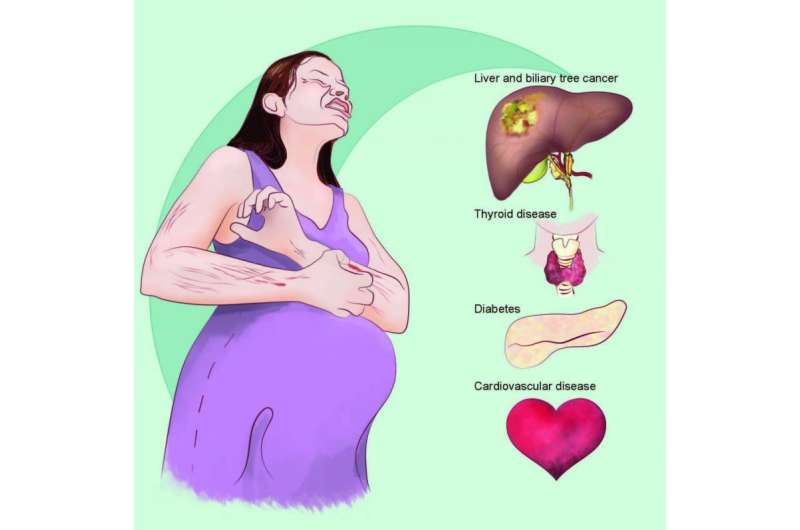Research links intrahepatic cholestasis of pregnancy with liver cancer and other diseases later in life

In a new study of more than 125,000 pregnant women in Sweden, researchers found that the risk of hepatobiliary cancer and immune-mediated and cardiovascular diseases later in life is higher in women with intrahepatic cholestasis of pregnancy (ICP) than in women without this condition. Their results are published in the Journal of Hepatology.
ICP affects nearly 0.4-1.5% of pregnancies and is characterized by otherwise unexplained itching (pruritus) with elevated serum bile acids and/or liver enzymes in the late second and third trimester of pregnancy. The condition is associated with risks for the unborn child, in particular preterm delivery, and less frequently stillbirth. For the mother, it has typically been regarded as an annoying but not serious condition that spontaneously resolves after delivery.
This new study has indicated that women with ICP are at increased risk of hepatobiliary cancer and immune-mediated and cardiovascular diseases after delivery.
"This large population-based study in women with ICP found increased risks of later hepatobiliary cancer and immune-mediated diseases and a small increased risk of later cardiovascular disease," explained principal investigator Hanns-Ulrich Marschall, MD, of Sahlgrenska Academy, Institute of Medicine, Department of Molecular and Clinical Medicine, University of Gothenburg, Gothenburg, Sweden.
Investigators linked the Swedish Medical Birth Register and the Swedish Patient Register and identified 11,388 women with ICP and 113,893 matched women without ICP, who gave birth between 1973 and 2009. Diagnoses of cancer and immune-mediated and cardiovascular diseases both before and after delivery were obtained from the Patient Register.
This study showed that women who had experienced ICP were at a 2.5-times higher risk for cancer in the biliary tree and at 3.5-times increased risk for liver cancer later in life compared with matched controls. Even after adjusting for a diagnosis of hepatitis C, which is very strongly associated with liver cancer, women with ICP were still at 2.5-times increased risk of later liver malignancy.
The data indicated that patients with ICP have an increased risk of a variety of immune-mediated diseases, such as thyroid disease (30% higher than pregnant controls), diabetes (47%), psoriasis (27%), and Crohn's disease (55%). Investigators also found a slightly increased risk of future cardiovascular disease, but only in women with both ICP and preeclampsia during pregnancy.
"We strongly recommend a follow-up of serum liver tests 6-12 weeks after delivery in all women with ICP, with and without persisting pruritus, and if serum liver test results are elevated, further evaluation by a hepatologist," noted Dr. Marschall and his co-investigators.
More information: "Intrahepatic cholestasis of pregnancy and cancer, immune-mediated and cardiovascular diseases: A population-based cohort study," by Elisabeth A. Wikström Shemer, Olof Stephansson, Marcus Thuresson, Malin Thorsell, Jonas F. Ludvigsson, and Hanns-Ulrich Marschall. DOI: dx.doi.org/10.1016/j.jhep.2015.02.022 . Published online in the Journal of Hepatology, in advance of Volume 63, Issue 2 (August 2015).

















